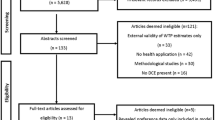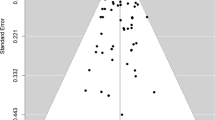Abstract
Based on the conceptual, methodological, and analytical framework of operant behavioral economics, hypothetical purchase task (HPT) questionnaires provide a low cost, scalable, and quantitatively rich source of empirical insights on consumer motivation, preferences, and decision-making. Here, we briefly summarize the history of HPT development and validation in clinically oriented research in addiction through to recent work with more conventional consumer goods and services. We discuss several possible novel applications of HPT methods to consumer behavior analysis for business, marketing, and public policy formulation and evaluation, as well as emerging best practices, limitations, and additional directions for future research and development.


Similar content being viewed by others
References
Adamowicz, W., Boxall, P., Williams, M., & Louviere, J. (1998). Stated preference approaches for measuring passive use values: choice experiments and contingent valuation. Am J Agric Econ, 80(1), 64–75. doi:10.2307/3180269.
Amlung, M. T., Acker, J., Stojek, M. K., Murphy, J. G., & MacKillop, J. (2012). Is talk “cheap”? An initial investigation of the equivalence of alcohol purchase task performance for hypothetical and actual rewards. Alcoholism-Clinical and Experimental Research, 36(4), 716–724. doi:10.1111/j.1530-0277.2011.01656.x.
Berry, S. T. (1994). Estimating discrete-choice models of product differentiation. RAND J Econ, 25(2), 242. doi:10.2307/2555829.
Bickel, W. K., Johnson, M. W., Koffarnus, M. N., MacKillop, J., & Murphy, J. G. (2014b). The behavioral economics of substance use disorders: Reinforcement pathologies and their repair. Annu Rev Clin Psychol, 10, 641–677. doi:10.1146/annurev-clinpsy-032813-153724.
Bickel, W. K., Wilson, A. G., Franck, C. T., Mueller, E. T., Jarmolowicz, D. P., Koffarnus, M. N., & Fede, S. J. (2014a). Using crowdsourcing to compare temporal, social temporal, and probability discounting among obese and non-obese individuals. Appetite, 75, 82–89.
Broadbent, J., & Dakki, M. A. (2015). How much is too much to pay for internet access? A behavioral economic analysis of internet use. Cyberpsychology, Behavior, and Social Networking, 18(8), 457–461. doi:10.1089/cyber.2014.0367.
Buhrmester, M., Kwang, T., & Gosling, S. D. (2011). Amazon’s Mechanical Turk a new source of inexpensive, yet high-quality, data? Perspect Psychol Sci, 6(1), 3–5.
Chase, H. W., MacKillop, J., & Hogarth, L. (2013). Isolating behavioural economic indices of demand in relation to nicotine dependence. Psychopharmacology, 226(2), 371–380. doi:10.1007/s00213-012-2911-x.
Collins, F. S., & Riley, W. T. (2016). NIH’s transformative opportunities for the behavioral and social sciences. Sci Transl Med, 8(366), 366ed14. doi:10.1126/scitranslmed.aai9374.
Daley, R. K., Nangle, J., Boeckman, G., & Miller, M. (2014). Refueling behavior of flexible fuel vehicle drivers in the federal fleet (No. NREL/TP-5400-61777). National Renewable Energy Laboratory. http://www.afdc.energy.gov/uploads/publication/refueling_behavior.pdf
Dhalla, N. K., & Yuspeh, S. (1976). Forget the product life cycle concept! Harv Bus Rev, 54(1), 102–112.
Epstein, L. H., Dearing, K. K., & Roba, L. G. (2010). A questionnaire approach to measuring the relative reinforcing efficacy of snack foods. Eat Behav, 11(2), 67–73.
Few, L. R., Acker, J., Murphy, C., & MacKillop, J. (2011). Test-retest reliability of the alcohol and cigarette purchase tasks. Alcoholism—Clinical and Experimental Research, 35(6), 163a.
Foxall, G. R. (2010). Invitation to consumer behavior analysis. J Organ Behav Manag, 30(2), 92–109. doi:10.1080/01608061003756307.
Giesen, J. C., Havermans, R. C., & Jansen, A. (2010). Substituting snacks with strawberries and sudokus: Does restraint matter? Health Psychol, 29(2), 222. doi:10.1037/a0017436.
Hantula, D. A., & Wells, V. K. (2013). Consumer behavior analysis: (a) rational approach to consumer choice. New York, NY: Routledge.
Houthakker, H. S. (1950). Revealed preference and the utility function. Economica, 17(66), 159–174. doi:10.2307/2549382.
Hursh, S. R. (1980). Economic concepts for the analysis of behavior. J Exp Anal Behav, 34(2), 219–238. doi:10.1901/jeab.1980.34-219.
Hursh, S. R. (1984). Behavioral economics. J Exp Anal Behav, 42(3), 435–452. doi:10.1901/jeab.1984.42-435.
Hursh, S. R. (2000). Behavioral economic concepts and methods for studying health behavior. In W. K. Bickel & R. E. Vuchinich (Eds.), Reframing health behavior change with behavioral economics. Mahwah, NJ, US: Lawrence Erlbaum Associates Publishers.
Hursh, S. R., Madden, G. J., Spiga, R., DeLeon, I. G., & Francisco, M. T. (2013). The translational utility of behavioral economics: The experimental analysis of consumption and choice. In G. J. Madden, W. V. Dube, T. D. Hackenberg, G. P. Hanley, & K. A. Lattal (Eds.), APA handbook of behavior analysis, Vol. 2: translating principles into practice (pp. 191–224). Washington, DC: American Psychological Association. doi:10.1037/13938-008.
Hursh, S. R. (2014). Behavioral economics and analysis of consumption and choice. In F. K. McSweeney & E. S. Murphy (Eds.), The Wiley Blackwell handbook of classical and operant conditioning, 1st Ed. (pp. 275-305). West Sussex, UK: John Wiley & Sons.
Hursh, S. R., & Roma, P. G. (2013). Behavioral economics and empirical public policy. J Exp Anal Behav, 99(1), 98–124. doi:10.1002/jeab.7.
Hursh, S. R., & Roma, P. G. (2016). Behavioral economics and the analysis of consumption and choice. Manag Decis Econ, 37, 224–238. doi:10.1002/mde.2724.
Hursh, S. R., & Silberberg, A. (2008). Economic demand and essential value. Psychol Rev, 115(1), 186–198. doi:10.1037/0033-295x115.1.186.
Jacobs, E. A., & Bickel, W. K. (1999). Modeling drug consumption in the clinic using simulation procedures: demand for heroin and cigarettes in opioid-dependent outpatients. Exp Clin Psychopharmacol, 7(4), 412–426. doi:10.1037/1064-1297.7.4.412.
Jarmolowicz, D. P., Lemley, S. M., Mateos, A., & Sofis, M. J. (2016a). A multiple-stimulus-without-replacement assessment for sexual partners: purchase task validation. J Appl Behav Anal, 49(3), 723–729. doi:10.1002/jaba.313.
Jarmolowicz, D. P., Reed, D. D., & Bickel, W. K. (2015). Neuroeconomics: implications for understanding and treating addictive behavior. In S. Feldstein Ewing, K. Witkiewitz, & F. Filbey (Eds.), Neuroimaging and psychosocial addiction treatment: an integrative guide for researchers and clinicians. London, UK: Palgrave Macmillan. doi:10.1057/9781137362650.
Jarmolowicz, D. P., Reed, D. D., DiGennaro Reed, F. D., & Bickel, W. K. (2016b). The behavioral and neuroeconomics of reinforcer pathologies: implications for managerial and health decision making. Manag Decis Econ, 37, 274–293. doi:10.1002/mde.2716.
Klepper, S. (1996). Entry, exit, growth, and innovation over the product life cycle. Am Econ Rev, 86(3), 562–583.
Koffarnus, M. N., Wilson, A. G., & Bickel, W. K. (2015). Effects of experimental income on demand for potentially real cigarettes. Nicotine Tob Res, 17(3), 292–298.
Loomis, J. B. (2014). Strategies for overcoming hypothetical bias in stated preference surveys. J Agric Resour Econ, 39(1), 34–46.
Louviere, J. J., Hensher, D. A., & Swait, J. D. (2000). Stated choice methods: analysis and applications. Cambridge, UK: Cambridge University Press.
MacKillop, J., Brown, C. L., Stojek, M. K., Murphy, C. M., Sweet, L., & Niaura, R. S. (2012). Behavioral economic analysis of withdrawal- and cue-elicited craving for tobacco: an initial investigation. Nicotine Tob Res, 14(12), 1426–1434. doi:10.1093/Ntr/Nts006.
MacKillop, J., Miranda, R. M., Monti, P. M., Swift, R. M., Murphy, J. G., Rohsenow, D. J., Tidey, J. W., et al. (2008a). Short-term test-retest reliability of a behavioral economic alcohol purchase task. Alcoholism—Clinical and Experimental Research, 32(6), 53a.
MacKillop, J., & Murphy, J. G. (2007). A behavioral economic measure of demand for alcohol predicts brief intervention outcomes. Drug Alcohol Depend, 89(2–3), 227–233. doi:10.1016/j.drugalcdep.2007.01.002.
MacKillop, J., Murphy, J. G., Ray, L. A., Eisenberg, D. T. A., Lisman, S. A., Lum, J. K., & Wilson, D. S. (2008b). Further validation of a cigarette purchase task for assessing the relative reinforcing efficacy of nicotine in college smokers. Exp Clin Psychopharmacol, 16(1), 57–65. doi:10.1037/1064-1297.16.1.57.
MacKillop, J., O’Hagen, S., Lisman, S. A., Murphy, J. G., Ray, L. A., Tidey, J. W., et al. (2010). Behavioral economic analysis of cue-elicited craving for alcohol. Addiction, 105(9), 1599–1607. doi:10.1111/j.1360-0443.2010.03004.x.
Madden, G. J., & Kalman, D. (2010). Effects of bupropion on simulated demand for cigarettes and the subjective effects of smoking. Nicotine Tob Res, 12(4), 416–422. doi:10.1093/ntr/ntq018.
Murphy, J. G., & MacKillop, J. (2006). Relative reinforcing efficacy of alcohol among college student drinkers. Exp Clin Psychopharmacol, 14(2), 219–227. doi:10.1037/1064-1297.14.2.219.
Murphy, J. G., MacKillop, J., Skidmore, J. R., & Pederson, A. A. (2009). Reliability and validity of a demand curve measure of alcohol reinforcement. Exp Clin Psychopharmacol, 17(6), 396–404. doi:10.1037/a0017684.
Murphy, J. G., MacKillop, J., Tidey, J. W., Brazil, L. A., & Colby, S. M. (2011). Validity of a demand curve measure of nicotine reinforcement with adolescent smokers. Drug Alcohol Depend, 113(2–3), 207–214. doi:10.1016/j.drugalcdep.2010.08.004.
Murphy, J., & MacKillop, J. (2005). Modeling demand for alcohol using a simulation procedure. Alcoholism—Clinical and Experimental Research, 29(5), 33a.
Murray, K. B. (1991). A test of services marketing theory: consumer information acquisition activities. J Mark, 55(1), 10–25. doi:10.2307/1252200.
Oliveira-Castro, J. M., Cavalcanti, P. R., & Foxall, G. R. (2016). What consumers maximize: brand choice as a function of utilitarian and informational reinforcement. Manag Decis Econ, 37(4–5), 360–371. doi:10.1002/mde.2722.
Oliveira-Castro, J. M., Foxall, G. R., Yan, J., & Wells, V. K. (2011). A behavioral-economic analysis of the essential value of brands. Behav Process, 87(1), 106–114.
Petry, N. M., & Bickel, W. K. (1998). Polydrug abuse in heroin addicts: a behavioral economic analysis. Addiction, 93(3), 321–335. doi:10.1046/j.1360-0443.1998.9333212.x.
Pickover, A. M., Messina, B. G., Correia, C. J., Garza, K. B., & Murphy, J. G. (2016). A behavioral economic analysis of the nonmedical use of prescription drugs among young adults. Exp Clin Psychopharmacol, 24(1), 38. doi:10.1037/pha0000052.
Pope Jr., H. G., Kean, J., Nash, A., Kanayama, G., Samuel, D. B., Bickel, W. K., & Hudson, J. I. (2010). A diagnostic interview module for anabolic-androgenic steroid dependence: preliminary evidence of reliability and validity. Exp Clin Psychopharmacol, 18(3), 203–213. doi:10.1037/a0019370.
Reed, D. D., Kaplan, B. A., Becirevic, A., Roma, P. G., & Hursh, S. R. (2016). Toward quantifying the abuse liability of ultraviolet tanning: a behavioral economic approach to tanning addiction. J Exp Anal Behav, 106(1), 93–106. doi:10.1002/jeab.216.
Reed, D. D., Kaplan, B. A., Roma, P. G., & Hursh, S. R. (2014). Inter-method reliability of progression sizes in a hypothetical purchase task: implications for empirical public policy. Psychol Rec, 64(4), 671–679. doi:10.1007/s40732-014-0076-1.
Reslan, S., Saules, K. K., & Greenwald, M. K. (2012). Validating a behavioral economic approach to assess food demand: effects of body mass index, dietary restraint, and impulsivity. Appetite, 59(2), 364–371.
Richter, M. K. (1966). Revealed preference theory. Econometrica, 34(3), 635–645. doi:10.2307/1909773.
Roma, P. G., Hursh, S. R., & Hudja, S. (2016). Hypothetical purchase task questionnaires for behavioral economic assessments of value and motivation. Manag Decis Econ, 37, 306–323. doi:10.1002/mde.2718.
Samuelson, P. A., & Nordhaus, W. D. (2010). Economics. New York, NY: McGraw-Hill Irwin.
Stigler, G. J. (1954). The early history of empirical studies of consumer behavior. J Polit Econ, 62, 95–113. doi:10.1086/257495.
Weinstock, J., Mulhauser, K., Oremus, E. G., & D’Agostino, A. R. (2016). Demand for gambling: development and assessment of a gambling purchase task. Int Gambl Stud, 16(2), 316–327. doi:10.1080/14459795.2016.1182570.
Acknowledgements
PGR and SRH’s contributions to this work were supported by intramural funds from the Institutes for Behavior Resources.
Author information
Authors and Affiliations
Corresponding author
Ethics declarations
All research protocols described in this paper were reviewed and approved by the responsible committees on such research, or determined to be exempt from review by the respective committees.
Conflict of Interest
The authors declare that they have no conflicts of interest.
Rights and permissions
About this article
Cite this article
Roma, P.G., Reed, D.D., DiGennaro Reed, F.D. et al. Progress of and Prospects for Hypothetical Purchase Task Questionnaires in Consumer Behavior Analysis and Public Policy. BEHAV ANALYST 40, 329–342 (2017). https://doi.org/10.1007/s40614-017-0100-2
Published:
Issue Date:
DOI: https://doi.org/10.1007/s40614-017-0100-2




